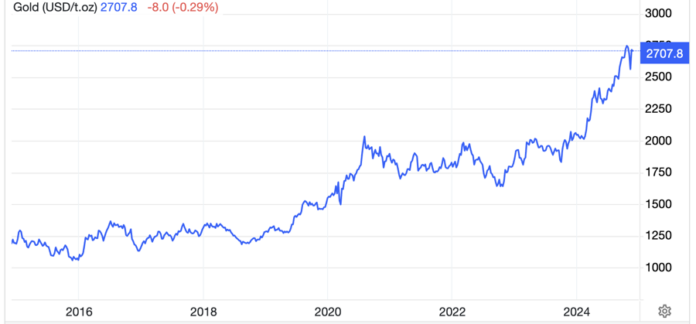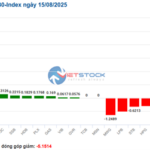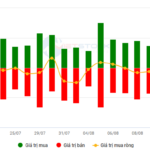Gold prices kicked off the new trading week with little movement, despite the US dollar pulling back from its two-year peak on Friday. After a strong recovery last week, some experts are skeptical about the sustainability of the precious metal’s rally, attributing it to temporary geopolitical tensions in Eastern Europe.
As of early Monday (November 25) in Vietnam, spot gold prices in Asian markets hovered around $2,717.40 per ounce, up by just $0.50 from its previous close in New York, according to Kitco data. At this level, the price is equivalent to about VND 83.5 million per tael, based on Vietcombank’s selling exchange rate.
Gold prices climbed 5.7% last week, marking the biggest weekly gain since March 2023. In Vietnamese dong terms, international gold prices rose by VND 4.4 million per tael over the week.
The main driver of gold’s rally last week was risk aversion, as the conflict between Russia and Ukraine escalated with the use of more dangerous weapons. Gold prices rose even as the US dollar strengthened, with the greenback also serving as a safe-haven asset.
The US Dollar Index, which measures the greenback against a basket of six major currencies, gained 0.75% last week, bringing its one-month increase to 3.1%, according to MarketWatch data. On Friday, the index closed at nearly 107.5 points, its highest level since late 2022.
In a report, Swiss bank UBS noted that gold’s strong performance last week reinforced its role as a “preferred hedge against geopolitical tensions.”
“On Thursday, Russia fired a supersonic missile at eastern Ukraine, which Ukrainian President Volodymyr Zelenskiy called ‘a clear and serious escalation.’ This move came after Ukraine used advanced Western-made missiles to target locations in Russia,” the report emphasized.
Given the circumstances, UBS maintained its target of $2,900 per ounce for gold prices in the coming year and until the end of 2025, partly because gold is also an asset that helps investors preserve value against “political pressures, including high public debt.”
Regarding the US dollar, UBS argued that the Dollar Index “is entering a period of uncertainty,” even though the incoming administration of President-elect Donald Trump could implement tariffs and pro-growth policies that would benefit the greenback in the short term.
“We believe that the US dollar’s appreciation is limited, and the currency may be overstretched,” the report said.
In a more cautious tone, Naeem Aslam, chief investment officer at Zaye Capital Market, said he wouldn’t be surprised if gold prices entered a consolidation phase this week, given the strong gains last week despite the rising US dollar and US stock market.
“It’s unusual for both risky and safe assets to rise together. The main reason here is that investors are reacting to escalating geopolitical tensions between Russia and Ukraine, but they remain optimistic that things won’t spiral out of control because they believe the incoming president could ease those tensions,” Aslam explained.

Similarly, Ole Hansen, head of commodity strategy at Saxo Bank, attributed the recent gold rally mainly to safe-haven demand, adding that “unless there are further escalations in Eastern Europe, gold’s upside from here may be limited until the market gets a clearer picture of Trump’s policies and the path of interest rates set by the Federal Reserve.”
However, Hansen pointed out that the safe-haven demand for gold due to geopolitical risks may not be sustainable, but the market still has strong faith in the precious metal’s upside. He emphasized that most of the selling pressure over the last three weeks came from speculators taking profits, and there was little evidence of short-selling, or betting on falling gold prices.
Year-to-date, gold prices have risen more than 30%, outpacing the 25% gain in the S&P 500, the broadest measure of US stocks.




































